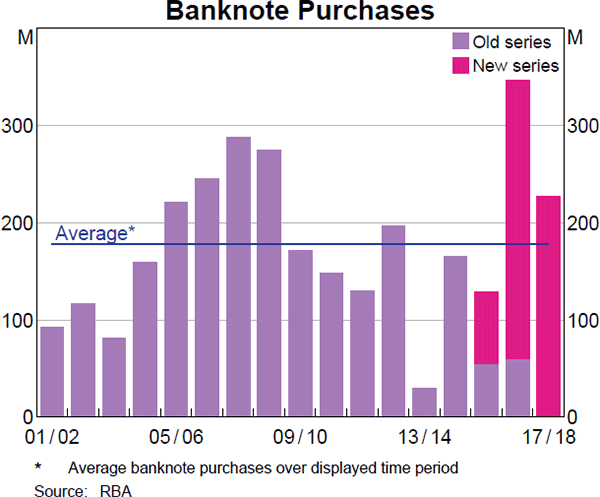Reserve Bank of Australia Annual Report – 2018 Banknotes
The Reserve Bank is responsible for producing and issuing Australia's banknotes. Public demand for banknotes stems from the role of banknotes as both a payment mechanism and store of value. To maintain the capacity of banknotes to perform these roles, the Bank seeks to ensure banknotes in circulation are of high quality and sufficient volume to meet public demand. The Bank conducts research and development to ensure that Australia's banknotes remain secure against counterfeiting. Based on this work, the Bank is issuing an upgraded series of banknotes with world-leading security features.
Circulation
The value of banknotes in circulation increased by 2.5 per cent over 2017/18, somewhat slower than in recent years. As at the end of June 2018, there were 1.6 billion banknotes, worth $76 billion or around 4 per cent of nominal GDP, in circulation. The ratio of the value of banknotes in circulation to nominal GDP remains at a historically high level, despite consumers increasingly using electronic payment alternatives for transactions. Growth in the $10 denomination was boosted by the introduction of the new $10 banknote, with many of the existing $10 banknotes not yet returned to the Reserve Bank. As at the end of June of 2018, new series banknotes made up around 60 per cent of all outstanding $5s and around 35 per cent of all outstanding $10s.
Distribution
The Reserve Bank maintains banknote holdings to accommodate: growth in the number of banknotes in circulation; seasonal fluctuations in demand; and contingency needs in the event of systemic shocks and production disruptions. The Bank has established distribution agreements with a number of commercial banks, which provide the banks with timely access to banknotes. The Reserve Bank issued banknotes worth $8.3 billion in 2017/18, of which around $1.9 billion had been in circulation previously and around $6.3 billion were new.
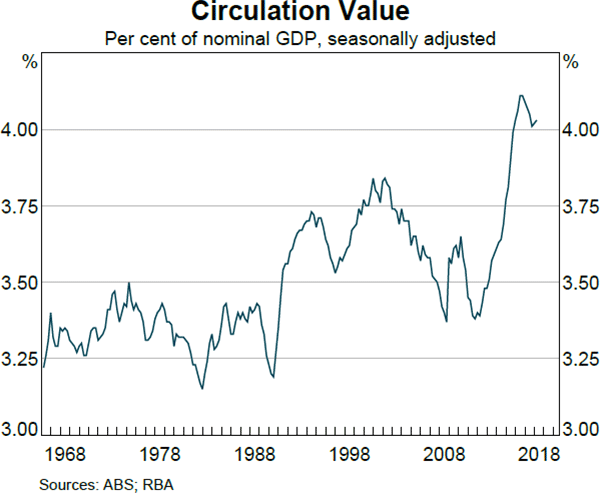
The Reserve Bank aims to maintain a high quality of banknotes in circulation to ensure their suitability as a payment mechanism and store of value. High-quality banknotes are more readily handled by machines and make it more difficult for counterfeits to be passed. For this reason, the Bank has arrangements that encourage the commercial banks and the cash-in-transit companies to continue to distribute banknotes that remain fit for circulation and return those that are unfit to the Bank's processing site in Craigieburn. These unfit (damaged) banknotes are assessed to confirm their authenticity and quality. In 2017/18, the Bank received $2.4 billion worth of banknotes, and almost all were deemed to be unfit for recirculation.
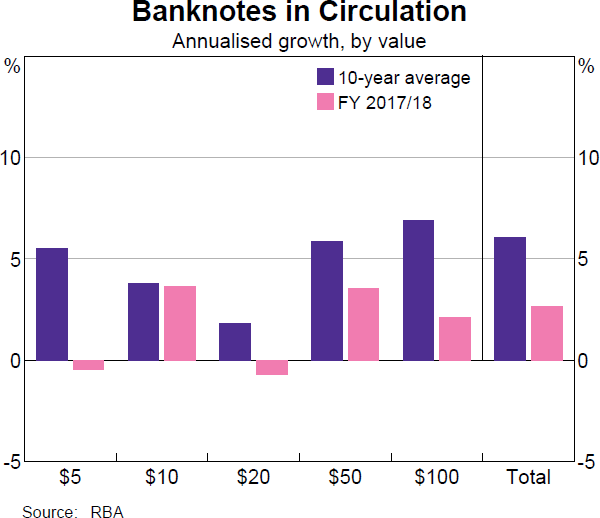
The Reserve Bank provides an additional service through its Damaged Banknotes Facility. The facility is offered to members of the public who have unwittingly come into possession of damaged banknotes or whose banknotes are accidentally damaged, with the aim to ensure that they do not face financial hardship. Claims that meet the requirements set out in the Bank's Damaged Banknotes Policy are paid based on their assessed value. The Bank processed 12,899 claims and made $6.9 million in payments in 2017/18. Of the damaged banknote claims processed in 2017/18, 31 claims worth $3.3 million were for banknotes that had been contaminated as a result of floods resulting from Cyclone Debbie in Queensland and New South Wales.
Counterfeiting Rates
The level of counterfeiting in Australia remains relatively low by international standards. In 2017/18, around 26,000 counterfeits, with a nominal value of nearly $2 million, were detected in circulation. This corresponds to around 16 counterfeits detected per million genuine banknotes in circulation, a 20 per cent reduction from 2016/17.
To combat counterfeiting in Australia, the Reserve Bank works closely with domestic and international law enforcement agencies to monitor trends and identify emerging threats. As part of this arrangement, the Bank provides analytical and counterfeit examination services and prepares expert witness statements and court testimonies to assist the agencies with their investigations.
In 2017/18, the Australian Federal Police and state police made a number of arrests and disrupted production of counterfeit banknotes on a number of occasions. During the year, the Commonwealth Department of Public Prosecutions prosecuted 44 matters involving possession, uttering (passing) and making of counterfeit currency.
| $5 | $10 | $20 | $50 | $100 | Total | |
|---|---|---|---|---|---|---|
| Number | 41 | 276 | 592 | 15,351 | 9,614 | 25,874 |
| Nominal value ($) | 205 | 2,760 | 11,840 | 767,550 | 961,400 | 1,743,755 |
| Parts per million | 0.2 | 2.0 | 3.5 | 21.6 | 28.2 | 16.4 |
|
(a) Figures are preliminary and subject to upward revision because of lags in counterfeit submissions to the RBA Source: RBA |
||||||
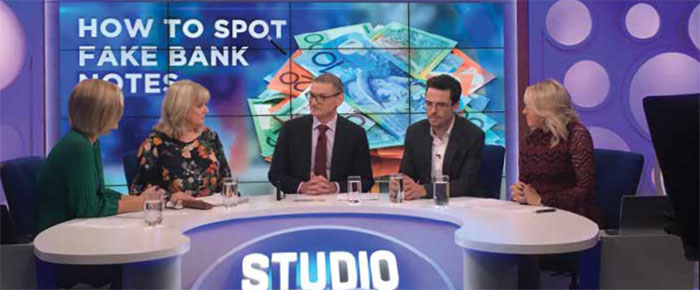
Next Generation Banknote Program
To ensure that Australian banknotes remain secure against counterfeiting, the Reserve Bank is issuing an upgraded series of banknotes. The new $5 banknote was released in 2016 and the new $10 banknote was released on 20 September 2017. A new $50 banknote is scheduled to enter general circulation in October 2018, with the remaining two denominations –$20 and $100 – to be issued in subsequent years.
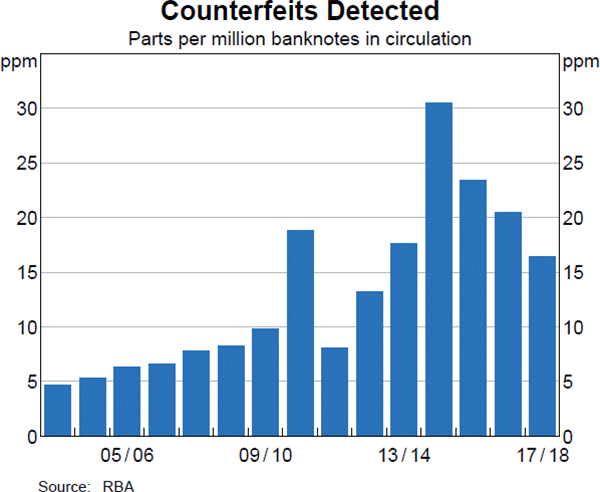
The Reserve Bank revealed the design of the new $50 banknote in February 2018. The design features David Unaipon and Edith Cowan, two Australians who were prominent campaigners for social change.
With $50 banknotes accounting for almost half of the banknotes in circulation, and the most targeted for counterfeiting, the release of the new $50 will enhance the security of the most widely circulating banknote. The new banknotes incorporate the latest technology such as the top-to-bottom window that contains optically variable security features, including a flying bird and reversing number, as well as the patch with rolling colour effect. The new banknotes also retain many of the key design elements of the first polymer banknote series, including the people portrayed, size and colour palette.
The cost of the Next Generation Banknote program, which was established in 2007, is budgeted at $37 million for all five denominations. The majority of the work program, focused on the new banknote development, has been completed and the Bank is on track to issue the remaining denominations within budget. To date, $32.2 million of this has been spent on designing and testing the new banknote series, as well as the related community consultation, communication and education initiatives.
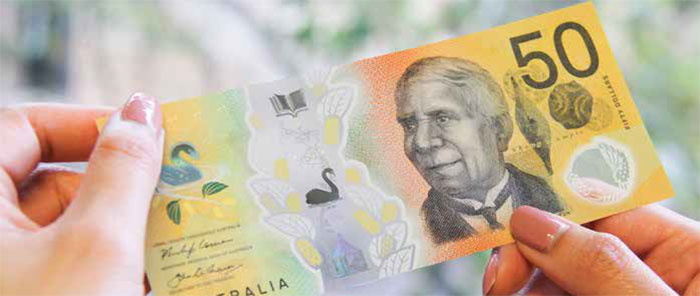
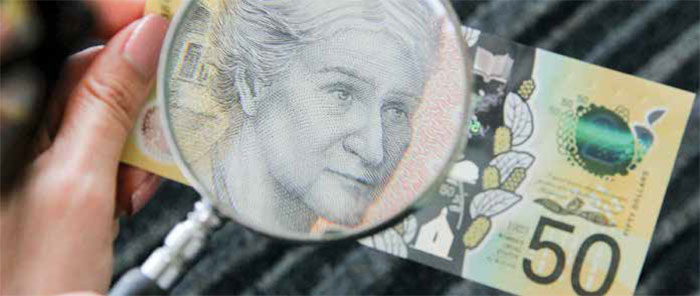
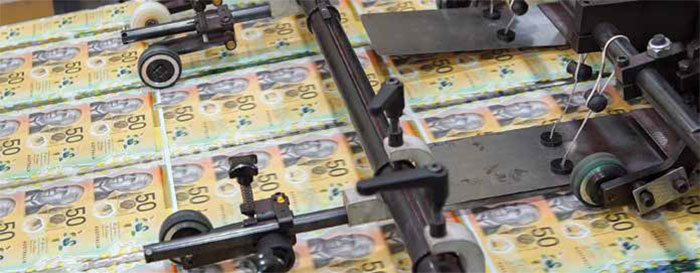

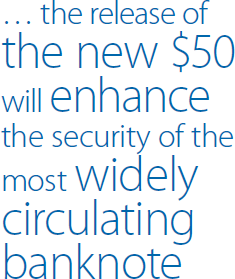
Industry Readiness
It is estimated there are now around half a million pieces of equipment, including ATMs, self-service checkouts, gaming machines and vending machines in Australia that need to process the new banknotes. The $50 is the most common banknote in circulation and accounts for the vast bulk of notes used in ATMs. Therefore, the Reserve Bank's engagement with machine manufacturers, deployers and owners has increased in focus and scope to help ensure the large number of machines will be ready for the new $50 banknote.
Regular communication with the industry is carried out and an online central hub of information is maintained to assist the cash-handling industry (including equipment manufacturers, financial institutions and other high-volume cash handlers, such as retailers and hospitality venues) to manage their equipment upgrades and educate their staff and customers about the new banknote series. Similar to the program for the new $10, the Reserve Bank is providing education and training materials. Bank staff have also continued to attend industry events and deliver presentations to share information about how to identify the security features of the new banknotes.
Public Communication
The Reserve Bank implemented a communication strategy to ensure that the public was well informed about the new banknotes and could readily identify the new security features.
Building on the high levels of awareness following the release of the new $5, a smaller advertising campaign was run for the new $10, predominantly on digital channels and also included some radio advertisements.
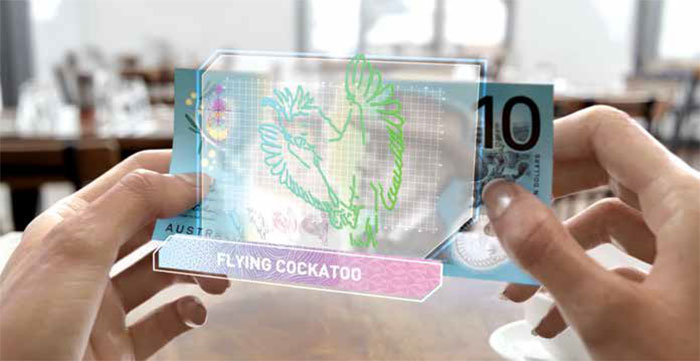


Additionally, for the new $10, the focus was on deepening the understanding of the security features of the new series of banknotes. The Reserve Bank hosted information stalls in various cities across Australia in places where members of the public are likely to be using cash to make payments. The face-to-face interaction with members of the public allowed the dynamic new features on the banknotes to be demonstrated.
During 2017/18, staff from Note Issue Department also continued to engage extensively with industry and members of the public to increase knowledge about the new and existing banknotes. More than 150 banknote-related presentations were given by Reserve Bank staff during 2017/18, with the majority delivered to visitors to the Reserve Bank of Australia Museum.
Banknote Infrastructure Modernisation Program
In preparation for the logistical demands arising from the introduction of the new banknote series, the Reserve Bank has completed a program to upgrade its existing banknote infrastructure. The program achieved its objectives to increase banknote storage and processing capacity, and to introduce new technologies and systems to improve banknote logistics processes and simplify distribution arrangements.
The upgrade involved construction of the National Banknote Site (NBS) at the Bank's existing Craigieburn site in Victoria. The NBS is a significant piece of national infrastructure that will store, process and distribute our banknotes for decades to come.
The main objectives of the upgrade were to introduce new sophisticated technologies and systems to improve banknote logistics processes and simplify distribution arrangements with cash-in-transit companies, and the implementation of new high-speed banknote processing machines. Banknote processing commenced at the NBS in December 2017 and, following a settling in process, banknote distribution operations commenced in August 2018.
The NBS consolidates all of the Reserve Bank's vaults in Victoria, and as a result, the banknote storage facility in the Bank's building in the Melbourne CBD was officially closed on 23 March 2018, marking the end of a significant chapter in the Bank's history.
The cost of constructing the NBS was $77 million over five years. Additional costs associated with modernising the infrastructure for banknote storage, processing and distribution amounted to $61 million over the same period. The amount is consistent with the budget approved by the Parliamentary Public Works Committee in 2015.
Research and Development
The Reserve Bank maintains an active research and development (R&D) program focused on researching new and emerging technologies that can be developed into future generations of security features and detection equipment. The primary aim of this program is to ensure that our banknotes remain highly secure against counterfeiting and easy to authenticate for a wide variety of users.
This is achieved in part through collaboration with domestic and international experts from various external organisations, including universities, public and private companies, research institutes and other central banks. Fundamental to this program is a continuing assessment of the vulnerability of banknotes to different forms of counterfeiting, the mechanisms by which banknotes wear in circulation, and how the public and banknote processing machines use and authenticate banknotes.
The Reserve Bank also works closely with its partners and suppliers to incorporate new technologies and features into the banknote production process. In 2017/18, the research program continued to focus on providing technical advice and expertise as part of the development of the new series of Australian banknotes by: conducting trials, assessing new technologies and developing strategies to ensure the durability of the new security features; providing advice on the security merit of designs; and developing instrumentation for banknote examination. This was done in conjunction with a redesign of the Reserve Bank's quality assurance program for new banknotes and development of new testing methodologies that will form part of this program.

(From left) Sivakumar Pavani from Bharatiya Reserve Bank Note Mudran Private Limited with Reserve Bank of Australia Assistant Governor (Business Services) Lindsay Boulton and Micaal Sidorov of Reconnaissance speaking at the High Security Printing Asia Conference, Melbourne, December 2017

Wael Mrad of Crane Currency (left) with Deputy Head of Note Issue Department James Holloway at the High Security Printing Asia Conference , Melbourne, December 2017
Note Printing Australia Limited (NPA)
NPA is a wholly owned subsidiary of the Reserve Bank that produces banknotes and supplies other related services to the Bank and some other entities. In 2017/18, NPA delivered 227 million Australian banknotes to the Bank, comprising around 44 million new series $10 banknotes and around 184 million new series $50 banknotes. This compared with 346 million Australian banknotes delivered to the Bank by NPA in 2016/17.
The aggregate amount paid by the Bank to NPA in 2017/18 for the supply of banknotes and related services was $82 million, compared with $99.9 million in the previous year.
In addition, NPA delivered 185 million banknotes under contract to Papua New Guinea, Singapore and Vanuatu in 2017/18, dealing directly with the respective central banks in those countries. NPA also produced 1.9 million P Series passports for Australia's Department of Foreign Affairs and Trade.
